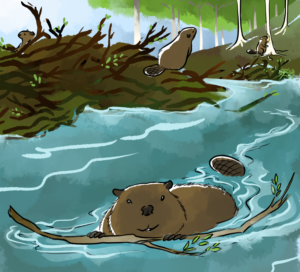I came across this and got all excited = like when I was a kid and found some of my mom’s old news blocking sheets…I think I started a newspaper about my siblings and transcribed several stories before I learned the hard way that “Maryjane got drunk once” was a story that pleased none of my readers…
This would be better:

Unfortunately it’s for the OSU football team, which recently caused great inconvenience by drafting a running back with the name Damien MARTINEZ so I keep getting news alerts for “Martinez beavers” and being disappointed.
Anyway this wasn’t about football, so that’s something…
How are the actual beavers in Corvallis doing?
 Corvallis is home to not only Oregon State University and its many students, but also the beavers we champion as our school’s mascot. OSU is seated on the Willamette River Valley (the mother of many rivers), which makes Corvallis a natural wetland perfect for beavers. There are protected parks too, like Avery Park, the Willamette River itself and Bald Hill Natural area, meaning sanctuaries exist for our mascot that ensure they aren’t driven out or built over. But what about long term threats, including climate change?
Corvallis is home to not only Oregon State University and its many students, but also the beavers we champion as our school’s mascot. OSU is seated on the Willamette River Valley (the mother of many rivers), which makes Corvallis a natural wetland perfect for beavers. There are protected parks too, like Avery Park, the Willamette River itself and Bald Hill Natural area, meaning sanctuaries exist for our mascot that ensure they aren’t driven out or built over. But what about long term threats, including climate change?
For a campus mythology built around these creatures, it’s surprising how little is known about their situation.
“There’s no research that I am aware of to suggest beaver populations are declining in Oregon,” John Stevenson, doctoral candidate for the Dept. Fisheries, Wildlife & Conservation Sciences, said. “Oregon Department of Fish and Wildlife has indicated that harvest levels from recreational trapping have been fairly stable.”
Hmm…”Patient stable” is the notorious chart note you right in the record at the psych hospital when you are behind in your paper work and can’t really remember anything they said in session…I assume it’s the same for ODFW…
Phew! Though not all news is good news for local beavers.
With global warming comes drastic changes in when we get our freshwater. The Oregon Cascades are getting less snowpack as temperatures become warmer, which is causing water to flow downstream earlier and earlier each year, an especially concerning problem for both salmon and beavers.
“A common hope is that watersheds where beavers are active will be more resilient to these impacts, but in reality the science has turned out to be somewhat mixed,” Stevenson said. “In some cases, beaver dams have increased groundwater storage and lowered summer stream temperature, but other studies have indicated that beaver dams can also do the opposite.”
This opens up the conversation about the extent to which beavers and climate change are interconnected. Despite beaver population levels remaining consistent, instability in beaver ecosystems from climate change may result in beavers behaving in new, impactfully-ambiguous ways to their surroundings.
No the data from the arctic tundra does not apply to Oregon. Stop jumping to conclusi0ns.
As OSU continues to change, so do Corvallis’ ecosystems, making it clear that even though research is being conducted in these areas, there can always be more work and more funding towards it.
“I’d keep funding the research I’m doing!” Stevenson said. “The first study in my dissertation suggests that we need to put more thought and research into where beavers’ activities align with our restoration goals and where they might not. I would put more resources into answering those questions.”
We’re beavers after all–and beavers look out for each other. Looking to the future, it’s important that OSU continues to support this level of research, not just for Benny, but for the ecosystems that beavers support as well.
And where the do not? Where are beavers not helping? Tell me more…
Stevenson shared a story about how his first year of PhD field work was full of “Caddyshack moments.” Testing for different ways to monitor water temperature had Stevenson and his crew struggling against beaver rule. Equipment had been cut from anchors, beavers had severed what their teeth could get through, and in one instance, equipment had been packed into a dam as if it were woody construction material.
According to Stevenson, Beavers in Corvallis are doing okay, and they continue to cultivate their environments into something more complex. For a school known for its engineering and forestry programs, it makes sense we’d have them as our mascot– not to mention our state’s!
But in our college worship of Benny and the fact that most OSU students and faculty have never seen a beaver in the flesh, it’s easy to misrepresent them in our mind as something transcendental. If we want to protect them, we have to know them.
“Beavers are fascinating in so many ways, not least of which is their ability to modify their environment and reengineer streams,” Stevenson said “In some ways, though, we’ve imposed on them an almost mythic status that is not always consistent with their actual life-history. As much as we want to think of beavers as little restoration-Roombas that we can set loose to clean up degraded streams, we need to remind ourselves that they are wild animals that will do what’s best for them. In some cases their behavior may align with our goals but there are numerous examples of when that is not always the case.”
Restoration Roombas??? Are you kidding me???






































